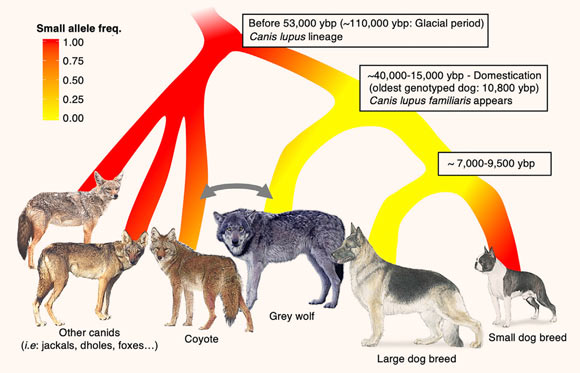Researchers have assembled a catalog of 1,431 genomes, inclusive of ancient canines, modern breed dogs, and wild canids, in a search for genetic variants passed from ancient to modern dogs. They’ve identify an ancient mutation in a growth hormone-regulating gene, which has been under human selection, that contributes to a significant portion of body size in modern dogs.

Plassais et al. identified an ancient mutation at the IGF1 locus that contributes to a significant portion of body size in modern dogs. Illustration by John James Audubon & John Bachman.
“Domestic dogs (Canis lupus familiaris) are the most variable-sized mammalian species on Earth, displaying a 40-fold size difference between breeds,” said lead author Dr. Jocelyn Plassais, a postdoctoral researcher with the National Human Genome Research Institute at the National Institutes of Health, and colleagues.
“Although dogs of variable size are found in the archeological record, the most dramatic shifts in body size are the result of selection over the last two centuries, as dog breeders selected and propagated phenotypic extremes within closed breeding populations.”
The search for the body size-associated mutation had been ongoing at the National Institutes of Health for over a decade, but researchers didn’t find it until Dr. Plassais suggested that they search for sequences around the gene that were positioned backwards and confirm if any were present in other canids and ancient DNA.
With this approach, the scientists found a reverse form of the insulin-like growth factor 1 (IGF1) gene with variants that correlated to dog body size.
“We looked at 200 breeds, and it held up beautifully,” said senior author Dr. Elaine Ostrander, a geneticist with the National Human Genome Research Institute.

Canidae ancestor was likely small and carried the C allele of the candidate SNP, rs22397284. The large allele arose some time before 53,000 years before present and generated bigger animals (Canis lupus). The ancestral small allele continues to exist in the gray wolf population, albeit at a low frequency. Approximately 15,000 years before present, canine domestication likely began with large wolf-like dogs. Shortly thereafter, human selection of small canids with the ancestral C allele led to a preponderance of small modern domestic breeds. Gray arrow reflects actual hybridization observed between coyotes and wolves in eastern part of America. Image credit: Plassais et al., doi: 10.1016/j.cub.2021.12.036.
The authors then looked at ancient wolf DNA to see when the IGF-1 mutation first showed up.
Scientists have theorized that dogs started out large and became smaller about 20,000 years ago, when they were domesticated, but this discovery presents the possibility of a new evolutionary narrative.
Indeed, when Dr. Plassais, Dr. Ostrander and their co-authors looked at the DNA of a 54,000-year-old steppe wolf (Canis lupus campestris) they found that it, too, possessed the growth hormone mutation.
“It’s as though Nature had kept it tucked in her back pocket for tens of thousands of years until it was needed,” Dr. Ostrander said.
The finding holds not just for dogs and wolves, but also for coyotes, jackals, African hunting dogs, and other members of the family of animals referred to as canids.
“This is tying together so much about canine domestication and body size, and the things that we think are very modern are actually very ancient,” Dr. Ostrander said.
The team now plans to continue to investigate the genes that regulate body size in dogs.
“One of the things that is pretty cool about dogs is that because they have evolved so recently there aren’t actually a lot of body size genes,” Dr. Ostrander said.
“Canids have only 25 known genes that regulate body size, compared to several hundred in humans.”
“I really want to understand the whole continuum — from Chihuahuas to Great Danes.”
The study appears in the journal Current Biology.
_____
Jocelyn Plassais et al. 2022. Natural and human-driven selection of a single non-coding body size variant in ancient and modern canids. Current Biology 32: 1-9; doi: 10.1016/j.cub.2021.12.036







